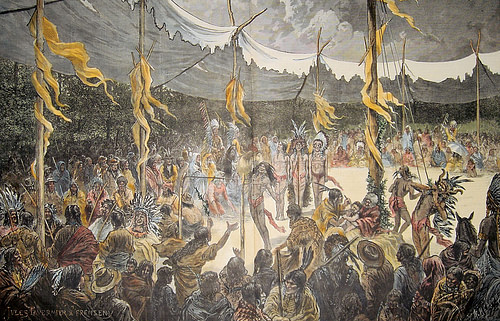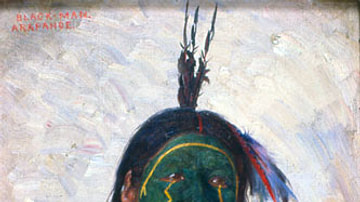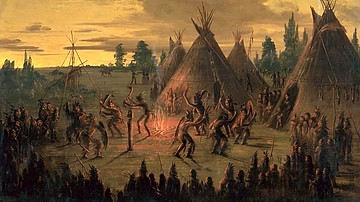The Arapaho Creation Story is the account of how the world was made from the mud at the bottom of the endless waters by Father (also given as Pipe Person in some versions) with the help of the duck and the turtle. The story is similar to one of the versions of the Cheyenne Creation Story.
Both of these accounts are also similar to the Lakota Sioux Creation Story as well as those of other Native American nations, many of which begin with the world as a great expanse of water and feature a central character – usually supernatural – who brings the earth into being with the help of waterfowl or the turtle. The Arapaho tale is also similar to that of the Cheyenne and others in that there is no mention of the concept of 'evil' or corruption. The Father, inspired by the Grandfather above, creates a perfect world, completely in balance. Any aspects of life humans will later find objectionable are entirely so because of their interpretation, not because of any flaws in the creation itself.
In some versions of the story, the Grandfather is the Creator God Be He Teiht (the Great Spirit) and Father (or Pipe Person) is understood as the First Arapaho, meaning the spirit of the Arapaho people, not the first man. In other versions, Father seems to be the Creator God and Grandfather is not mentioned or the Father figure goes by the name of Flat Pipe or, as noted, Pipe Person. There are also variations in how humans, plants, and animals are made in different versions, but, in all, the world is created for the greater good and its inhabitants, all related as family, are expected to share it generously with each other.
Versions of the Story & Arapaho Religion
These different versions of the Arapaho Creation Story are all fragmented and some incomplete because they were passed down through oral transmission by the people's storytellers, and so many of these were killed by US troops and settlers in the latter part of the 19th century – in conflicts such as the Sand Creek Massacre – or died of diseases or malnutrition on reservations that the story was almost lost completely. The best-known and most complete version comes from Traditions of the Arapaho by George A. Dorsey and Alfred L. Kroeber in 1903, given below.
In this version of the tale, after the duck and turtle have brought up the primordial mud, Father creates the earth and then the sun and moon before creating humans out of clay. In another version, he accomplishes this through prayer-thought – purposeful thought generating change – and literally thinks the world into being. All things, therefore, come from the mind of the Father, and are all closely related. This is a core belief of Arapaho spirituality – the close connection of all living things that inhabit the World House together. In the World House, every living thing is a brother or sister and all children of the same Father. This belief informed Arapaho rituals, including the Sun Dance, as well as the "medicine" objects (spiritual artifacts) the people carried. Scholar Loretta Fowler comments:
[One version of] the Arapaho origin story focuses on Pipe Person's creation of the earth from mud below the surface of an expanse of water. Pipe Person, through prayer-thought, created all life, including the first Arapahos. Arapahos henceforth kept a replica of the Flat Pipe as a symbol of their covenant with the life force or power on which Pipe Person drew. Rites centered on the pipe bundle helped ensure the success of Arapahos generally and of individuals specifically. Seven men's and seven women's medicine bags contained objects and implements that symbolized forms of power, and these passed from one custodian to another. Prayer-thoughts could affect events and lives, and the sincerity of a petitioner's prayer-thought was validated by sacrifices of property or of the body by flesh offerings and fasting. (1)
Although the Arapaho observed the Sun Dance, they did not engage in the self-torture aspect of that ritual as the Sioux and other Plains Indians did. The "flesh offerings" Fowler mentions would be sacrifices of an individual nature, though still performed for the greater good. The Sun Dance was known as the Offerings Lodge to the Arapaho and, instead of self-torture, they would donate personal items or space (land) to the community. The flat pipe was (and still is) central to the Offerings Lodge ceremony – as it is to other Arapaho rituals – as it symbolizes their connection to the Creator just as the Sioux ceremonial pipe does to that nation. When the Arapaho separated into Northern and Southern, and were then forcibly relocated to reservations, the Northern Arapaho kept the flat pipe with them, and the Southern Arapaho kept the sacred stones symbolizing the pipe. These are still used in rituals today.
In yet another version of the Arapaho Creation Story, this one incomplete, the flat pipe is featured prominently. In this tale, the Creator God is known as Flat Pipe and he walks about on the endless water with his pipe (a flat pipe) looking for some place where he can safely rest it. His entire purpose in creating the world is for a place to securely rest the pipe because, from this pipe, he will draw the power to begin the work of creation. He appeals to a flock of ducks flying past and they dive down into the water for him, bringing up some mud. This is not enough to create land from, however, and so he then asks various other creatures for help. One by one, they dive into the deep, six times, but none of them are able to reach the bottom. The seventh time, the turtle goes and brings back the right amount of mud for creation to begin.
Although the name of the main character and certain details differ in these versions, the central message remains the same: as all things were brought forth by the Creator, all are related to each other as family. One should therefore treat the earth, plants, animals, and others as kindly as one would one's own blood relatives because, in fact, that is what they all are.
Text
The first of the two versions below seems to combine the story of Flat Pipe with the one given by Dorsey and Kroeber in 1903. It is an abstract of the Creation Story written by scholar Andrew Cowell of the University of Colorado and is said to be based on the George Dorsey version. Cowell's abstract omits the Grandfather, however, and seems closer to the Flat Pipe version cited by scholar Larry J. Zimmerman in his Sacred Wisdom of the Native Americans.
The second version is the well-known story from Dorsey and Kroeber. This version is thought to be the most complete but is still regarded as fragmented and missing lines or passages from the original orally transmitted tale, especially toward the end, in the last two paragraphs. It also seems some words may have been mistranslated (or maybe the error is a simple typo) as the "never" in the last line – "and that the animals should never be worthy to belong to any of these lodges" – makes more sense as "ever" as in "always" since the Arapaho had a close relation to all animals and the narrator has just finished explaining that the animals should be part of the lodges.
The Arapaho Story of Creation
There was a deluge, nothing but water. A man was walking around on the water for four day and four nights, carrying a Flat Pipe. He wondered what he could do to protect it. For a total of six days he walked around with the Pipe, weeping and fasting.
On the morning of the seventh day, he decided that there needed to be earth for the Pipe to rest on. So he called to the four directions (northwest, northeast, southeast, and southwest) for people to come and help find land. Then he called forth seven cottonwood trees (though there was still no dry land), and then called forth creatures of the air and of the sea.
He asked if anyone knew where land was. The Turtle said that it was at the bottom of the ocean. So, the Man asked the animals if they could dive down and find it. A series of creatures dives for the land. First: The Grebe; Second: two waterfowls; Third: three waterfowls, including the Kingfisher; Fourth: Otter, Beaver, Packed Bird (coot), and Garter snake; Fifth: black snake, two kinds of ducks, goose, and crane; Sixth: all the creatures dive. But each time, they fail.
Then, the seventh dive is made by Turtle in the company of the Man. Before the Man dives, he ritually moves the Flat Pipe four times, then touches it to his body a fifth time. It turns into a Red-headed Duck, and it accompanies him on the dive along with the Turtle. Both the Duck and the Turtle succeed in bringing up a sod of earth for the Man (Arapaho).
The Man then dried the earth, then cast it in four directions (southeast, southwest, northwest, and northeast) and created the Earth.
An Arapaho Origin Myth
In the first place there was nothing but water, except the waterfowls; and the Grandfather saw that there was a Father [Flat Pipe] of the Indians floating on the water, on the four sticks (tripod). Knowing that that person floating on the water was fasting and weeping and crying and, seeing that he was really fasting for the good, the Grandfather took mercy on him. So, the Father floating on the water, and who was fasting on this tripod, called all the water-fowls, and so they all came.
"Now," says this man, "I want some of you who can do the work of diving to come and search for the bottom of the sea and see if you can find dirt." So, they all came in rotation according to their size. And they dived and came out dead. It took some days for these birds to dive.
Finally, it was the turn of the duck, who was somewhat timid about doing this work, and he said, "I guess I will try my luck and see if I can do this work." So the duck dived and was a few days and nights under the water, and the Father who was on the tripod was anxiously watching to see the return of the duck, and the time came and he saw the sign of its return on the surface of the water as though the duck was coming. And as the duck came out of the surface of the water (his feet closed the moment he barely reached the bottom) it had mud stuck to its claws.
The Father took it and cleaned its feet, and the mud that was on its feet he put on his pipe. Still, it was not satisfactory. There was not enough to do good. So the turtle came swimming toward the tripod and said, "I am going to try too." So, he went down and down days and nights, for a long time. Toward the last the man saw the bubbles coming up. The circles of water began to form, and the turtle came up with his feet closed together.
The Father took him and stretched his legs apart and took the mud off from the four feet. And these were the two animals that did the work in diving to the bottom of the sea to get the clay. The Father took the clay and put it with the other and spread it out thin and then he dried it. As soon as the clay was dry, he went to work and just took a piece of this clay and blew it toward the northeast, and then toward the southeast and then toward the northwest, and then toward the southwest, and what was left he took and gave it a swing and commanded that the earth come. Then he took a rod and made different motions over the waters for the rivers. Where the dirt was the thickest, he caused mountains.
After the earth was made, there was nothing to grow. It was barren. This man then says, "I have to have servants to watch and to dig the earth." So, the Father made the sun and moon, to represent man and woman. After this, he said, "Before I do more, I have got to make a man and to make a woman to inhabit this earth to represent the sun and the moon." So, he went to work to make clay images of those two people, man and woman. So, he made them out of clay. There they were in clay. The sun causes the trees, the grass and the vegetation to grow. After the sun and moon had been made and these two people, he caused the trees and the grass and vegetation and the animals and beasts and birds to live.
Then these two people, man and woman, were identical. This man and woman were virtuous at that time. There was nothing of connection at that time. It was commanded that there be a day and night, seasons of the year and that there should be summer and winter, that the grass be new one season and old one season. When the command was made that there were to be lodges, the Willow Lodge was commanded to be, and also other lodges—the Thunderbird, Club-Board, Buffalo Women's, Sweat Lodge, Lime-Crazy, Dog-Soldier and the Old Men's lodge. The oldest one was the Sweat lodge.
Man was now asked, "Where are you going to place yourself?" After thinking of it some time he left it entirely with the Father, and they were left just the way they were, and time passed on and on, and all the fruits grew. Then the Father said for male and female beasts of every description and fowls, genital organs shall be located, but for the human beings—choice in how they shall be located—that shall be decided later on.
Then the Father told this man and woman that all the lodges or commands laid down for them should be made up of birds, beasts, and the different kinds of plants and fruits and that the animals should never be worthy to belong to any of these lodges.







